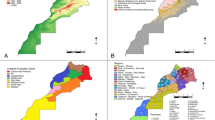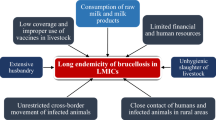Abstract
Brucellosis is a considerable public health and economic burden in many areas of the world including sub-Saharan Africa, the Middle East and former USSR countries. The collapse of the USSR has been cited as a driver for re-emergence of diseases including brucellosis, and human incidence rates in the former Soviet republics have been estimated as high as 88 per 100,000 per year. The aim of this paper is to examine the historical trends in brucellosis in Kazakhstan and to explore how livestock systems, veterinary services and control policies may have influenced them. In conclusion, a brucellosis epidemic most likely began before the collapse of the USSR and high livestock densities may have played an important role. Changes to the livestock systems in Kazakhstan, as well as other factors, are likely to have an impact on the success of brucellosis policies in the future. Incentives and practicalities of different policies in smallholder settings should be considered. However, the lack of reliable estimates of brucellosis prevalence and difficulties in understanding exactly how policy is being applied in Kazakhstan, which is a vast country with low population density, prevent firm conclusions from being drawn.


Similar content being viewed by others
References
Abzalova R, Wickham C, Chukmaitov A, Rakhipbekov T (1998) Reform of Primary Health Care in Kazakhstan and the Effects on Primary Health Care Worker Motivation: The Case of Zhezkazgan Region. Bethesda, MD: Abt Associates, Oct. Major Applied Research 5, Working Paper 3
Agency of Statistics of the Republic of Kazakhstan (n.d.). http://www.stat.gov.kz/faces/homePage;jsessionid=gGJ1SfMGVcKvc5McpJj612Vs3SysDfNHGFF0y9CCFqMTnJnyZ5Nj!-1706878266?_afrLoop=11307513112604&_afrWindowMode=0&_afrWindowId=null#@?_afrWindowId=null&_afrLoop=11307513112604&_afrWindowMode=0&_adf.ctrl-state=tcti13byq_4. Accessed 22 Jan 2014
Alimaev II, Behnke R (2007) Ideology, land tenure and livestock mobility in Kazakhstan. In: Fragmentation in Semi-Arid and Arid Landscapes, Galvin K, Reid R, Behnke R, Hobbs N (editors), Heidelberg, Germany: Springer, pp 45–91.
Alimaev II, Kerven C, Torekhanov A, Behnke R, Smailov K, Yurchenko V, Sisatov Z, Shanbaev K (2008) The impact of livestock grazing on soils and vegetation around settlements in Southeast Kazakhstan. In: The Socio-Economic Causes and Consequences of Desertification in Central Asia, Behnke R (editor), Bishkek, Kygyzstan: Springer Science + Business Media, pp 81–112.
Aparicio ED (2013) Epidemiology of brucellosis in domestic animals caused by Brucella melitensis, Brucella suis and Brucella abortus. Revue scientifique et technique (International Office of Epizootics) 32(1):53–60.
Avila-Calderón ED, Lopez-Merino A, Sriranganathan N, Boyle SM, Contreras-Rodríguez A (2013) A history of the development of Brucella vaccines. BioMed Research International 2013:1–8.
Berezovskiy DV (2012) Risk factors for brucellosis in rural areas-Almaty region, Kazakhstan, September 2010-July 2012. Journal of Central Asian Health Service Research 11:3.
Bkmentsova MM (1955) Materials relating to the Occurrence of Nidi of Brucellosis in Kazakhstan 157–166 Available: http://www.cabdirect.org/abstracts/19561000382.html. Accessed 16 Oct 2014
Bonfoh B, Kasymbekov J, Dürr S, Toktobaev N, Doherr MG, Schueth T, Zinsstag J, Schelling E (2012) Representative Seroprevalences of Brucellosis in Humans and Livestock in Kyrgyzstan. Ecohealth 9(2):132–138.
Central Intelligency Agency (n.d.) The World Factbook. https://www.cia.gov/library/publications/the-world-factbook/geos/kz.html. Accessed 1 Mar 2013
Corbel MJ (1997) Brucellosis: an overview. Emerging Infectious Diseases 3(2): 213–21.
Corbel MJ (2006) Brucellosis in Humans and Animals. Geneva, Switzerland: World Health Organization ISBN 9789241547130.
Dean AS, Crump L, Greter H, Hattendorf J, Schelling E, Zinsstag J (2012a) Clinical manifestations of human brucellosis: a systematic review and meta-analysis. PLoS Neglected Tropical Diseases 6(12): e1929.
Dean AS, Crump L, Greter H, Schelling E, Zinsstag J (2012b) Global burden of human brucellosis: a systematic review of disease frequency. PLoS Neglected Tropical Diseases 10(6): e1865.
Denisov AA, Sclyarov OD, Salmakov KM, Shumilov, KV (2013) The Russian experience in brucellosis veterinary public health. Revue Scientifique et Technique Office International des Épizooties 32(1): 229–237.
Food and Agriculture Organization (2010) Brucella melitensis in Eurasia and Middle East. FAO Animal Production and Health Proceedings. No. 10. Rome
Getty JA, Naumov OV, Sher B (2010). Document 164. Politburo decision on sabotage of livestock. In The Road to Terror: Stalin and the Self-Destruction of the Bolsheviks, 1932-1939 (Annals of Communism Series), Yale University Press
Godfroid J, Käsbohrer A (2002) Brucellosis in the European Union and Norway at the turn of the twenty-first century. Veterinary Microbiology 90(1-4): 135–45.
Grushina TA (2005) Features of brucellosis in Kazakhstan: distribution, epidemiology, diagnostics, treatment, prevention; mechanism of formation of Brucella spp. population virulence level and mechanism of brucellosis pathogenesis in specific natural hosts and man, depending on social and environmental conditions. Final Project Summary. Almaty, Kazakhstan: Kazakh Scientific Center for Quarantine and Zoonotic Diseases. Contract No. ISTC K-318.Sponsored by the USA
Grushina T, Tabatabai L, Tserelson L, Syzdykov M, Rementsova M, Daulbayeva S, Beketov B, Ospanov K, Kouznetsov A, Amireyev S (2003) Diagnostics of human brucellosis caused by Brucella melitensis. In: Brucellosis 2003 International Research Conference including the 56th Brucellosis Research Conference (proceedings), Pamplona, Spain, pp 15-17
Hugh-Jones ME, Ellis PR, Felton MR (1975) An assessment of the eradication of bovine brucellosis in England and Wales. Berkshire: University of Reading.
Kerven C, Alimaev II, Behnke R, Davidson G, Malmakov N, Smailov A, Wright I (2006) Fragmenting pastoral mobility: changing grazing patterns in post-soviet Kazakhstan. In: USDA Forest Service Proceedings, Bedunah DJ, Durant McArthur E, Fernandez-Gimenez M (editors), Fort Collins, CO: Rocky Mountain Research Station, pp 99–110.
Lundervold M (2001) Infectious diseases of saiga antelopes and domestic livestock in Kazakhstan (Phd Thesis). University of Warwick, UK. Available: http://www.iccs.org.uk/wp-content/thesis/lundervold-thesis.pdf. Accessed 16 Oct 2014
Lundervold M, Milner-Gulland EJ, O’Callaghan CJ, Hamblin C, Corteyn A, Macmillan AP (2004) A serological survey of ruminant livestock in Kazakhstan during post-Soviet transitions in farming and disease control. Acta Veterinaria Scandinavica 45(3–4):211–24.
Ministry of Agriculture of the Republic of Kazakhstan (2003) Kazakhstan’s farm animal genetic resources. Astana, Kazakhstan: Country Report to the Food and Agriculture Organization.
Mizanbayeva S, Smits HL, Zhalilova K, Abdoel TH, Kozakov S, Ospanov KS, Elzer PH, Douglas JT (2009) The evaluation of a user-friendly lateral flow assay for the serodiagnosis of human brucellosis in Kazakhstan. Diagnostic Microbiology and Infectious Disease 65(1):14–20.
Morgan ER, Torgerson PR, Shaikenov BS, Usenbayev AE, Moore ABM, Medley GF, Milner-Gulland E J (2006) Agricultural restructuring and gastrointestinal parasitism in domestic ruminants on the rangelands of Kazakhstan. Veterinary Parasitology 139(1–3):180–91.
Ragan V, Vroegindewey G, Babcock S. (2013) International standards for brucellosis prevention. Revue scientifique et technique (International Office of Epizootics) 32(1):189–98.
Rechel B, Ahmedov M, Akkazieva B, Katsaga A, Khodjamurodov G, McKee M (2012) Lessons from two decades of health reform in Central Asia. Health Policy and Planning 27(4):281–7.
Rementsova (1987) Brucellosis in wild animals. South Asia Books
Robinson S, Milner-Gulland EJ (2003) Political change and factors limiting numbers of wild and domestic ungulates in Kazakhstan. Human Ecology 31(1):87–110.
Russo G, Pasquali P, Nenova R, Alexandrov T, Ralchev S, Vullo V, Rezza G, Kantardjiev T (2009) Reemergence of human and animal brucellosis, Bulgaria. Emerging Infectious Diseases 15(2):314–6.
Sattarov AI, Amireev SA (1983) Characteristics of brucellosis epidemiology in children in the Kazakh SSR. Zh Mikrobiol Epidemiol Immunobiol 9:92–4.
Shaikenov BS, Torgerson PR, Usenbayev AE, Baitursynov KK, Rysmukhambetova AT, Abdybekova AM, Karamendin, KO (2003) The changing epidemiology of echinococcosis in Kazakhstan due to transformation of farming practices. Acta Tropica 85(2):287–93.
Shaikenov BS, Vaganov TF, Torgerson PR (1999) Cystic echinococcosis in Kazakhstan: an emerging disease since independence from the Soviet Union. Parasitology Today 15(5):172–4.
Spoor M (2004) Agricultural restructuring and trends in rural inequalities in Central Asia: a socio-statistical survey. Geneva, Switzerland: United Nations Research Institute for Social Development. Civil Society and Social Movements Programme Paper Number 13
Studentsov KP (1965) Some questions of diagnosis of brucellosis and specific preventive measures in the Kazakh Soviet Republic. Bulletin Office international des épizooties 63(7):1245–51.
Suleimenov M, Oram P (2000) Trends in feed, livestock production, and rangelands during the transition period in three Central Asian countries. Food Policy 25(6):681–700.
Torgerson PR (2013) The emergence of echinococcosis in central Asia. Parasitology 140(13):1667–73.
Vitek CR, Wharton M (1998) Diphtheria in the former Soviet Union: reemergence of a pandemic disease. Emerging Infectious Diseases 4(4):539–50.
Vlassov VV, Danishevskiy KD (2008) Biomedical journals and databases in Russia and Russian language in the former Soviet Union and beyond. Emerging Themes in Epidemiology 5:15.
Wolfram JH, Butaev MK, Duysheev A, Gabbasova AR, Khasanov OS, Kulakov YK, Mkrtchyan AR, Myrzabekov AM, Nurgaziev, RZ, Tsirel’son LE, Willer RD, Yaraev RG, Zheludkov MM (2010) Epidemiology chapter. Vaccine 28(Suppl 5):F77–F84.
WHO (n.d.) Seven neglected endemic zoonoses some basic facts. World Health Organization available: http://www.who.int/zoonoses/neglected_zoonotic_diseases/en/. Accessed 6 Jan 2014
World Trade Organization (n.d.) Accession status: Kazakhstan. Available: http://www.wto.org/english/thewto_e/acc_e/a1_kazakhstan_e.htm. Accessed 13 Jan 2014
Zinsstag J, Kasymbekov J, Schelling E, Bonfoh B (2012) It’s time to control brucellosis in Central Asia. Evidence for Policy Series, Regional edition Central Asia, No 2. Bishkek, Kyrgyzstan and Abidjan, Côte d’ivoire: NCCR North-South
Acknowledgments
We sincerely thank Steffen Zuther (ACBK), Albert Salemgareyev (ACBK) and Mukhit Orynbaev (RIBSP) for assistance in reaching remote areas of Kazakhstan, facilitating meetings with livestock-owners, veterinarians and local officials, and interpreting. We thank Richard Kock for establishing and introducing our contacts in Kazakhstan. The primary author was funded by a Royal Veterinary College Internal PhD Scholarship.
Author information
Authors and Affiliations
Corresponding author
Rights and permissions
About this article
Cite this article
Beauvais, W., Coker, R., Nurtazina, G. et al. Policies and Livestock Systems Driving Brucellosis Re-emergence in Kazakhstan. EcoHealth 14, 399–407 (2017). https://doi.org/10.1007/s10393-015-1030-7
Received:
Revised:
Accepted:
Published:
Issue Date:
DOI: https://doi.org/10.1007/s10393-015-1030-7




